18.1: Ratio Analysis and Statement Evaluation
18.1.1: Financial Statements Across Periods
Companies prepare three financial statements according to GAAP rules: the income statement, the balance sheet, and the cash flow statement.
Learning Objective
Identify the three main financial statements that companies generally submit
Key Points
- The income statement gives an account of what the company sold and spent in the year (revenues and expenses).
- The balance sheet is a financial snapshot of the company’s assets and liabilities, and informs shareholders about its financial health.
- The cash flow statement shows what came into and went out of the company in cash. It gives a better idea than the other two financial statements about how well the company can meet its cash obligations.
- The Securities and Exchange Commission (SEC) regulates these financial statements. Companies must file extensive reports annually (known as a 10K), as well as quarterly reports (10Q).
- A company may report its financials in a fiscal year that is different from the calendar year.
Key Terms
- 10Q
-
A quarterly report mandated by the United States federal Securities and Exchange Commission to be filed by publicly traded corporations.
- generally accepted accounting principles
-
The standard framework of guidelines for financial accounting used in any given jurisdiction; generally known as accounting standards. GAAP includes the standards, conventions, and rules accountants follow in recording and summarizing, and in the preparation of financial statements.
- 10K
-
An annual report, required by the U.S. Securities and Exchange Commission (SEC), that gives a comprehensive summary of a public company’s performance.
Example
- Publicly traded companies must make their financial statements available for all to see. These can be found on a financial website, such as finance.yahoo.com.
Financial statements are records that outline the financial activities of a business, individual, or any other entity . Corporations report financial statements following Generally Accepted Accounting Principles (GAAP). The rules about how financial statements should be put together are set by the Financial Accounting Standards Board (FASB). Standardized rules ensure, to some extent, that a firm’s financial statements accurately represent the company’s financial status.

Financial Statements Analysis
Corporations report financial statements following Generally Accepted Accounting Principles (GAAP).
Companies generally submit three forms of financial statements. The information contained in these statements, and how this information fluctuates across periods, is very telling for investors and government regulatory agencies. These three financial statements are:
The income statement (also called the “profit and loss statement”): This gives an account of what the company sold and spent in the year. Sales (also called “revenues”), or what the company sold in products and services, less any expenses (expenses are divided into a number of categories) and less taxes, gives the company’s income. The income statement summarizes all this type of activity for the year.
The balance sheet: This is a financial snapshot of what the company owns (assets), what it owes (liabilities), and its worth free and clear of debt (or the value of its equity). Analyzing a balance sheet informs shareholders about the company’s financial health.
The cash flow statement: It tells what transactions went into and came out of the company in the form of cash. This is necessary because accounting sometimes deals with revenues and expenses which are not real cash, such as accounts receivable and accounts payable. Looking at the actual cash flow gives a better idea of how well the company can meet its cash obligations.
The period represented in a given financial statement can vary. A company may report its financials in a fiscal year that is different from the calendar year. While some firms do follow the calendar year, others–such as retail companies–prefer not to follow the calendar year due to seasonality of sales or expenses, et cetera.
The reporting of these financial statements is regulated by the federal agency, the Securities and Exchange Commission (SEC). According to SEC regulations, companies have to file an extensive report (called the 10K) on what happened during the year. In addition to the 10K, companies have to file 10Qs every three months, which give their quarterly financial performance. These reports can be accessed through the SEC’s website, www.sec.gov, the company’s website, or various financial websites, such as finance.yahoo.com.
18.1.2: Profitability Ratios
Profitability ratios are used to assess a business’s ability to generate earnings.
Learning Objective
Compare the information given by calculating the various profitability ratios
Key Points
- Profitability ratios are used to compare companies in the same industry, since profit margins will vary widely from industry to industry.
- Taxes should not be included in these ratios, since tax rates will vary from company to company.
- The profit margin shows the relationship between profit and sales and is mostly used for internal comparison.
- Profit Margin = Net Profit / Net Sales. It shows the relationship between profit and sales and is mostly used for internal comparison.
- ROE = Net Income / Shareholder Equity. It measures a firm’s efficiency at generating profits from every unit of shareholders’ equity.
- The BEP ratio compares earnings before income and taxes to total assets. BEP = EBIT / Total Assets.
Key Terms
- financial leverage
-
The degree to which an investor or business is utilizing borrowed money.
- Cost of Goods Sold
-
Cost of goods sold (COGS) refer to the inventory costs of those goods a business has sold during a particular period.
- profitability
-
The capacity to make a profit.
Example
- Company A had a net income last year of ten thousand dollars. It operated with two thousand five hundred dollars worth of assets. Thus, its ROA = 10000 / 2500 = 4. Therefore, it derives four dollars for each dollar of assets it owns. In that time, its net sales were fifty thousand dollars. Thus, the Profit Margin = 10000 / 50000 = 20 percent. This figure should be compared to its competitors in order to determine whether this is healthy or not.
Profitability Ratios
Profitability ratios show how much profit the company takes in for every dollar of sales or revenues. They are used to assess a business’s ability to generate earnings as compared to expenses over a specified time period .

Increasing Profits
Profitability ratios are used to assess a business’s ability to generate earnings.
Profitability ratios are going to vary from industry to industry, so comparisons should be between other companies in the same field. When comparing companies in the same industry, the company with the higher profit margin is able to sell at a higher price or lower expenses. They tend to be more attractive to investors.
Net Profit Margins and Returns on Sales
Many analysts focus on net profit margins or returns on sales, which are calculated by taking the net income after taxes and dividing by the revenues or sales. This ratio uses the bottom line on the income statement to calculate profit for every dollar of sales or revenues. The operating margin takes the profit before taxes further up the income statement and divides by revenues. Operating margins are also important, since they focus on the operating income and operating expenses. Other profitability ratios include:
- Return on Assets: The return on assets ratio (ROA) is found by dividing the net income by total assets. The higher the ratio, the better the company is at using their assets to generate income (i.e., how many dollars of earnings they derive from each dollar of assets they control). It is also a measure of how much the company relies on assets to generate profit. The return on assets gives an indication of the company’s capital intensity, which will depend on the industry. Companies that require large initial investments will generally have reduced return on assets.
- Profit Margin: The profit margin is one of the most used profitability ratios. The profit margin refers to the amount of profit that a company earns through sales. The profit margin ratio is broadly the ratio of profit to total sales times one hundred percent. The higher the profit margin, the more profit a company earns on each sale. The profit margin is mostly used for internal comparison. It is difficult to accurately compare the net profit ratio for different entities. A low profit margin indicates a low margin of safety and a higher risk that a decline in sales will erase profits and result in a net loss or a negative margin.
- Return on Equity: The return on equity (ROE) measures profitability related to ownership. It measures a firm’s efficiency at generating profits from every unit of the shareholders’ equity. ROEs between 15 percent and 20 percent are generally considered good. The ROE is equal to the net income divided by the shareholder equity.
- Basic Earning Power Ratio: The basic earning power ratio (or BEP ratio) compares earnings separately from the influence of taxes or financial leverage to the assets of the company. The BEP is equal to the earnings before interest and taxes divided by the total assets. The BEP differs from the ROA in that it includes the non-operating income.
- Gross Profit Ratio: This indicates what portion of each sales dollar is available to meet expenses and generate profit after taking into account the cost of goods sold. Generally, it is calculated as the selling price of an item minus the cost of goods sold (production or acquisition costs).
18.1.3: Liquidity Ratios
Liquidity ratios measure how quickly assets can be turned into cash in order to pay the company’s short-term obligations.
Learning Objective
Compare the current ratio to the quick ratio
Key Points
- Liquidity ratios should fall within a certain range—too low and the company cannot pay off its obligations, or too high and the company is not utilizing its cash efficiently.
- Current Ratio = Current Assets / Current Liabilities. This ratio examines whether a firm can cover its short-term debts. If below 1, the company may have difficulty meeting short-term obligations.
- Acid Test Ratio (or Quick Ratio) = [Current Assets – Inventories] / Current Liabilities. More stringent and meaningful than the Current Ratio, since it does not include inventory. A ratio of 1:1 is recommended, but not necessarily a minimum.
- A company can improve its liquidity ratios by raising the value of its current assets, reducing current liabilities by paying off debt, or negotiating delayed payments to creditors.
Key Terms
- liquidity ratio
-
total cash and equivalents divided by short-term borrowings
- liquidity
-
An asset’s ability to become solvent without affecting its value; the degree to which it can be easily converted into cash.
- creditor
-
A person to whom a debt is owed.
Example
- Company X has $1,000 dollars in cash, and $2,000 worth of inventory to be sold. Company X owed Company Y $1,000 dollars. X’s Current Ratio = 3000 / 1,000 = 3, and so can be considered healthy. X’s Acid Test Ratio = 1,000 / 1,000 = 1, which means that it can pay off short-term obligations. It is also not too high, and so cash is not idle.
Liquidity ratios measure a company’s ability to pay short-term obligations of one year or less (i.e., how quickly assets can be turned into cash). A high liquidity ratio indicates that a business is holding too much cash that could be utilized in other areas. A low liquidity ratio means a firm may struggle to pay short-term obligations.
One such ratio is known as the current ratio, which is equal to:
Current Assets ÷ Current Liabilities.
This ratio reveals whether the firm can cover its short-term debts; it is an indication of a firm’s market liquidity and ability to meet creditor’s demands. Acceptable current ratios vary from industry to industry. For a healthy business, a current ratio will generally fall between 1.5 and 3. If current liabilities exceed current assets (i.e., the current ratio is below 1), then the company may have problems meeting its short-term obligations. If the current ratio is too high, the company may be inefficiently using its current assets or its short-term financing facilities. This may also indicate problems in working capital management.
The acid test ratio (or quick ratio) is similar to current ratio except in that it ignores inventories. It is equal to:
(Current Assets – Inventories) Current Liabilities.
Typically the quick ratio is more meaningful than the current ratio because inventory cannot always be relied upon to convert to cash. A ratio of 1:1 is recommended. Low values for the current or quick ratios (values less than 1) indicate that a firm may have difficulty meeting current obligations. Low values, however, do not indicate a critical problem. If an organization has good long-term prospects, it may be able to borrow against those prospects to meet current obligations.
A firm may improve its liquidity ratios by raising the value of its current assets, reducing the value of current liabilities, or negotiating delayed or lower payments to creditors.

Cash
Cash is the most liquid asset in a business.
18.1.4: Debt Utilization Ratios
Debt ratios provide information about a company’s long-term financial health.
Learning Objective
Explain the methods and usage of debt utilization ratios
Key Points
- Generally speaking, the more debt a company has (as a percentage of assets), the less healthy it is financially.
- Debt Ratio = Total Debt / Total Assets. It shows the percentage of a company’s assets that are provided through debt. The higher the ratio, the greater the risk the company has undertaken.
- Debt-to-Equity Ratio (D/E) = Debt (i.e. Liabilities) / Equity. It shows the split of shareholders’ equity and debt that are used to finance the company’s assets.
- The DCR shows the ratio of cash available for debt servicing to interest, principal, and lease payments. The higher this ratio, the easier it is for a company to take on new debt.
Key Terms
- debt financing
-
funding obtained by borrowing assets
- amortization
-
The reduction of loan principle over a series of payments.
- debt
-
Money that one person or entity owes or is required to pay to another, generally as a result of a loan or other financial transaction.
- Interest
-
The price paid for obtaining or price received for providing money or goods in a credit transaction, calculated as a fraction of the amount or value of what was borrowed.
Example
- If Company F has $100,000 in assets, and $10,000 in total liabilities, it would have a debt ratio of 10,000 / 100,000 = 10%. Company G, on the other hand, may have $100,000 worth of assets and $200,000 worth of liabilities. In this case, it has a debt ratio of 200%.
Debt utilization ratios provide a comprehensive picture of the company’s solvency or long-term financial health. The debt ratio is a financial ratio that indicates the percentage of a company’s assets that are provided via debt. It is the ratio of total debt (the sum of current liabilities and long-term liabilities) and total assets (the sum of current assets, fixed assets, and other assets such as “goodwill”).
Debt Ratio = Total Debt / Total Assets
For example, a company with $2 million in total assets and $500,000 in total liabilities would have a debt ratio of 25%. The higher the ratio, the greater the risk associated with the firm’s operation. In addition, high debt to assets ratio may indicate low borrowing capacity of a firm, which in turn will lower the firm’s financial flexibility. Like all financial ratios, a company’s debt ratio should be compared with their industry average or other competing firms.
The debt-to-equity ratio (D/E) is a financial ratio indicating the relative proportion of shareholders’ equity and debt used to finance a company’s assets. When used to calculate a company’s financial leverage, the debt usually includes only the Long Term Debt (LTD). D/E = Debt(liabilities)/Equity.
The debt service coverage ratio (DSCR), also known as debt coverage ratio (DCR), is the ratio of cash available for debt servicing to interest, principal, and lease payments. It is a popular benchmark used in the measurement of an entity’s ability to produce enough cash to cover its debt (including lease) payments. The higher this ratio is, the easier it is to obtain a loan. In general, it is calculated as:
DSCR = (Annual Net Income +
Amortization
/
Depreciation
+ Interest
Expense
+ other non-cash and discretionary items (such as non-contractual
management
bonuses)) / (Principal Repayment + Interest payments + Lease payments)
A similar debt utilization ratio is the times interest earned (TIE), or interest coverage ratio. It is a measure of a company’s ability to honor its debt payments. It may be calculated as either EBIT or EBITDA, divided by the total interest payable. EBIT is earnings before interest and taxes, and EBITDA is earnings before interest, taxes, depreciation, and amortization.
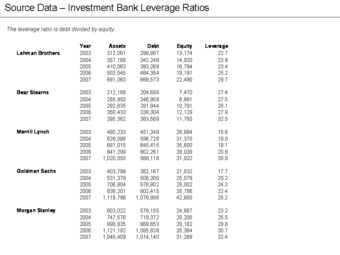
Leverage Ratios
Leverage ratios for some investment banks
18.1.5: Comparisons Within an Industry
Most financial ratios have no universal benchmarks, so meaningful analysis involves comparisons with competitors and industry averages.
Learning Objective
Explain how to effectively use financial statement analysis
Key Points
- Ratios allow easier comparison between companies than using absolute values of certain measures. They negate the impact of scale in profitability or solvency.
- Firms should generally try to meet or exceed the industry average, over time, in their ratios.
- Industry trends, changes in price levels, and future economic conditions should all be considered when using financial ratios to analyze a firm’s performance.
Key Terms
- solvency
-
The state of having enough funds or liquid assets to pay all of one’s debts; the state of being solvent.
- bankruptcy
-
A legally declared or recognized condition of insolvency of a person or organization.
Example
- Suppose Company Z has $100,000 in assets and $40,000 in total liabilities, it would have a debt ratio of 40,000 / 100,000 = 40%. If the industry average is 50%, then Company Z is in a good financial position debt-wise. Alternatively, if the industry average over time is only 25%, then Company Z should consider ways to reduce its debt.
Financial statement analysis (or financial analysis) is the process of reviewing and analyzing a company’s financial statements to make better economic decisions. These statements include the income statement, balance sheet, statement of cash flows, and a statement of retained earnings. Financial statement analysis is a method or process involving specific techniques for evaluating risks, performance, financial health, and future prospects of an organization.
Financial statements can reveal much more information when comparisons are made with previous statements, rather than when considered individually. Horizontal analysis compares financial data, such as an income statements, over a period of several quarters or years. When comparing past and present financial information, one will want to look for variations such as higher or lower earnings. Moreover, it is often useful to compare the financial statements of companies in related industries.
Ratios of risk such as the current ratio, the interest coverage, and the equity percentage have no theoretical benchmarks. It is, therefore, common to compare them with the industry average over time. If a firm has a higher equity ratio than the industry, this is considered less risky than if it is below the average. Similarly, if the equity ratio increases over time, it is a good sign in relation to insolvency risk.
The main purpose of conducting financial analysis is to measure a business’s profitability and solvency. The actual metrics tracked and methods applied vary from stakeholder to stakeholder, depending on his or her interests and needs. For example, equity investors are interested in the long-term earnings power of the organization and perhaps the sustainability and growth of dividend payments. Creditors want to ensure the interest and principal is paid on the organizations debt securities (e.g., bonds) when due.
Most analytical measures are expressed as percentages or ratios, which allows for easy comparison with other businesses in the industry regardless of absolute company size. Vertical analysis, which is a proportional analysis of financial statements, lists each line item in the financial statement as the percentage of another line item. For example, on an income statement each line item will be listed as a percentage of gross sales. This technique is also referred to as normalization or common-sizing.
When using these analytical measures, one should take the following factors into consideration:
- Industry trends;
- Changes in price levels;
- Future economic conditions.
Ratios must be compared with other firms in the same industry to see if they are in line .

Refining Operation
Ratio analyses can be used to compare between companies within the same industry. For example, comparing the ratios of BP and Exxon Mobil would be appropriate, whereas comparing the ratios of BP and General Mills would be inappropriate.
18.1.6: Performance per Share
Valuation ratios describe the value of shares to shareholders, and include the EPS ratio, the P/E ratio, and the dividend yield ratio.
Learning Objective
Identify the ratio analysis tools used for shares of stock
Key Points
- EPS (Earnings Per Share) = Net Income / Average Common Shares. This ratio gives the earnings per outstanding share of a company’s stock.
- P/E Ratio = Market Price per Share / Annual Earnings per Share. This ratio is widely used to measure the relative value of companies. The higher the P/E ratio, the more investors are paying for each unit of net income.
- Current Dividend Yield = Most Recent Full Year Dividend / Current Share Price. Displays the earnings distributed to stock holders in relation to the value of the stock.
- Market To Book ratio is used to compare a company’s current market price to its book value.
Key Terms
- stockholder
-
One who owns stock.
- dividend
-
A pro rata payment of money by a company to its shareholders, usually made periodically (e.g., quarterly or annually).
Company Performance Per Share
The below ratios describe the value of shares of stock to stockholders, both in terms of dividends and their general ownership value:
- Earnings Per Share (EPS) is the amount of earnings per each outstanding share of a company’s stock. Companies are required to report EPS for each of the major categories of the income statement, including: continuing operations, discontinued operations, extraordinary items, and net income. EPS = Net Income / Average Common Shares.
- Price to Earnings (P/E) ratio relates market price to earnings per share. The P/E ratio is a widely used metric used for measuring the relative value of companies. A higher P/E ratio means that investors are paying more for each unit of net income; therefore, the stock is more expensive compared to one with a lower P/E ratio. The P/E ratio also shows the number of years of earnings which would be required to pay back the purchase price—ignoring inflation, earnings growth and the time value of money. P/E Ratio = Market Price Per Share / Annual Earnings Per Share .
- Dividend Yield ratio shows the earnings distributed to stockholders related to the value of the stock, as calculated on a per-share basis. The dividend yield or the dividend-price ratio of a share is the company’s total annual dividend payments divided by its market capitalization—or the dividend per share, divided by the price per share. It is often expressed as a percentage. Current Dividend Yield = Most Recent Full Year Dividend / Current Share Price.
- Dividend Payout ratio shows the portion of earnings distributed to stockholders. Dividend payout ratio is the fraction of net income a firm pays to its stockholders in dividends: Dividend Payout Ratio = Dividends / Net Income for the Same Period. The part of earnings not paid to investors is left for investment to provide for future earnings growth. Investors seeking high current income and limited capital growth prefer companies with a high dividend payout ratio. However, investors seeking capital growth may prefer a lower payout ratio, because capital gains are taxed at a lower rate. High growth firms in early life generally have low or zero payout ratios. As they mature, they tend to return more of the earnings back to investors.
- Market To Book ratio is used to compare a company’s current market price to its book value. The calculation can be performed in two ways, but the result should be the same using either method. In the first method, the company’s market capitalization can be divided by the company’s total book value from its balance sheet (Market Capitalization / Total Book Value). The second method, using per-share values, is to divide the company’s current share price by the book value per share, which is its book value divided by the number of outstanding shares (Share Price / Book Value Per Share). A higher market to book ratio implies that investors expect management to create more value from a given set of assets, all else equal. This ratio also gives some idea of whether an investor is paying too much for what would be left if the company went bankrupt immediately.
18.1.7: Activity Ratios
Activity ratios provide useful insights regarding an organization’s ability to leverage existing assets efficiently.
Learning Objective
Calculate activity ratios to determine organizational efficiency
Key Points
- Organizations are largely systems of assets that produce outputs. The efficiency of how those assets are used can be measured via activity ratios.
- There are a number of different activity ratios commonly used by stakeholders and managers to assess overall organizational efficiency, most importantly asset turnover, inventory turnover, and degree of operating leverage.
- Different businesses and industries tend to focus more on some activity ratios than others. Knowing what ratio is relevant based on the operation or process is an important consideration for managerial accountants.
- Inventory turnover is highly relevant for industries selling perishable or time sensitive goods. On the other hand, manufacturing facilities tend to be more concerned with fixed asset turnover.
Key Terms
- leverage
-
To use in such a way to capture maximum value.
- perishable
-
A good that has an expiration date, or can go bad.
Why Firms Measure Activity
Activity ratios are essentially indicators of how a given organization leverages their existing assets to generate value. When considering the nature of a business, the general concept is to generate value through utilizing various production processes, employee talent, and intellectual property. Through identifying the profit compared to the investment in these core assets, the overall efficiency of the organization’s utilization can be derived.
How to Measure Activity
There are a number of ways to measure activity. Each calculation has different inputs and different implications. Some examples include:
- Average collection period – (Accounts Receivable)/(Daily Average Credit Sales)
- Degree of Operating Leverage (DOL) – (Percent Change in Net Operating Income)/(Percent Change in Sales)
- DSO Ratio – (Accounts Receivable)/(Daily Average Sales)
- Average Payment Period – (Accounts Payable)/(Average Daily Credit Purchases)
- Asset Turnover – (Net Sales)/(Total Assets)
- Stock Turnover Ratio – (Cost of Goods Sold)/(Average Inventory)
- Receivables Turnover Ratio – (Net Credit Sales)/(Average Net Receivables)
- Inventory Conversion Ratio – (365 Days)/(Inventory Turnover)
- Receivables Conversion Period – (Receivables/Net Sales)(365 Days)
- Payable Conversion Period – (Receivables/Net Sales)(365 Days)
- Cash Conversion Cycle – Inventory Conversion Period + Receivable Conversion Period – Payable Conversion Period
Using Activity Ratios
By tracking these metrics over time, and comparing them to the competition, organizations and stakeholders can gauge their competitiveness and overall capacity to leverage assets in the current industry. Understanding how to use these ratios, and what the implications are, is central to financial and managerial accounting at the strategic level.
For some business, inventory turnover is an incredibly important metric. A business selling farmed produce, for example, must have a highly sophisticated value chain with minimal warehousing and storage. Inventory turnover must be rapid, as the goods being sold are perishable. Fashion industries are similarly reliant on inventory turnover, as the seasonality of both fashion styles and climate create a strong necessity for careful activity management.
For other businesses, asset turnover is a central activity metric. A manufacturing facility producing semiconductors, for example, will invest heavily in the production facility and related equipment. Ensuring maximum production and annual sales contracts is integral to maintaining profitability, and maximizing utilization of those fixed assets will enormously impact profitability.
18.1.8: Sample Evaluation
Most of the ratios discussed can be calculated using information found in the three main financial statements.
Learning Objective
Apply financial ratio analysis to Bounded Inc.
Key Points
- Keep in mind that for most ratios, the number must be compared against competitors and industry standards for it to be meaningful.
- The ROE (Return on Equity) measures the firm’s ability to generate profits from every unit of shareholder equity.
- ROEs between 15 percent and 20 percent are generally considered good.
Key Term
- ROA
-
The return on assets (ROA) percentage shows how profitable a company’s assets are in generating revenue.
Consider the company Bounded Inc., a magazine publisher, to illustrate the financials of a company. The following information is based on the company’s FY (financial year) 2011 performance:
- Cash: $3,230
- Cost of Goods Sold: $2,390
- Current Assets: $1,000
- Current Liabilities: $3,500
- Depreciation: $800
- Fixed Assets: $8,600
- Interest Payments: $300
- Inventory: $2,010
- Long-term Debt: $3,000
- Sales: $5,000
Using the information above, we can compile the balance sheet and the income statement. We can also calculate some financial ratios to determine the company’s financial situation. Keep in mind that for most ratios, the number must be compared against competitors and industry standards for it to be meaningful:
ROA (Return on Assets) = Net Income / Total Assets = 1,057 / 13,840 = 7.6%
This means that for every dollar of assets the company controls, it derives $0.076 of profit. This would need to be compared to others in the same industry to determine whether this is a high or low figure.
Profit Margin = Net Income / Net Sales = 1,057/5,000 = 21.1 percent
This figure would need to be compared to competitors. A lower profit margin indicates a low margin of safety.
ROE (Return on Equity) = Net Income / Shareholder Equity = 1,057/7,340 = 14.4 percent
The ROE measures the firm’s ability to generate profits from every unit of shareholder equity. 0.144 (or 14 percent) is not a bad figure, but by no means a very good once, since ROE’s between 15 to 20 percent are generally considered good.
BEP Ratio = EBIT / Total Assets = 1,810/13,840 = 0.311
Current Ratio = Current Assets / Current Liabilities = 5,240/3,500 = 1.497
This demonstrates that the company does not seem to be in a tight position in terms of liquidity.
Quick Ratio = (Current Assets-Inventories) / Current Liabilities = (5,240 – 2,010) / 3,500 = 0.923
Despite having a current ratio of about 1.0, the quick ratio is slightly below 1.0. This means that the company may face liquidity problems should payment of current liabilities be demanded immediately. But it does not seem to be a huge cause for concern.
Debt Ratio = Total Debt / Total Assets = 6,500/13,840 = 47 percent
This indicates the percentage of a company’s assets that are provided via debt. The higher the ratio, the greater risk will be associated with the firm’s operation.
D/E Ratio = Long-term Debt/Equity = 3,000/7,340 = 40.9 percent
This shows the relative proportion of shareholders’ equity and debt used to finance a company’s assets. Once again, comparisons should be made between companies in the same industry in order to determine whether this is a low or high figure.
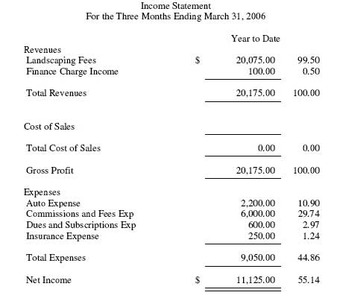
Financial Statement
One form of financial statement is the income statement.
18.2: Accounting Information
18.2.1: Usage of Accounting Information
Accounting is the vehicle for reporting financial information about a business entity to many different groups of people.
Learning Objective
Explain the history of accounting and how accounting information is useful
Key Points
- The American Accounting Association defines accounting as “the process of identifying, measuring and communicating economic information to permit informed judgements and decisions by users of the information.”
- Accounting involves two main elements: (1) an information process summarizing financial events; and (2) a reporting system that communicates financial information to interested parties.
- Double-entry bookkeeping first emerged in Northern Italy in the 14th century, where trading ventures began to require transactions that involved more than one investor.
- Management (or internal) accounting and financial (or external) accounting are generally the two key branches of accounting.
- Management accounting provides relevant and useful information to people inside the business, such as employees, managers, owners and auditors. It provides information for decision making and company strategy.
- Financial accounting, on the other hand, also provides information to people outside the business, such as investors, regulators, analysts, economists, and government agencies.
Key Terms
- double-entry bookkeeping
-
A method of bookkeeping in which each transaction must have at least one debit and one credit.
- Financial statements
-
Standardized documents that include the financial information of a person, company, government, or organization; this information is used to make financial decisions.
- accounting
-
The process of identifying, measuring and communicating economic information to permit informed judgements and decisions by users of the information. (definition by the American Accounting Association)
- stakeholders
-
People outside of a company who have a special interest in the company. Some examples are suppliers, customers, and the community.
Using Accounting Information
The American Accounting Association defines accounting as “the process of identifying, measuring and communicating economic information to permit informed judgements and decisions by users of the information.” In other words, it is the process of communicating financial information about a business entity to stakeholders and managers. Economic information is generally displayed in the form of financial statements that show the economic resources that a business currently has; the goal of the business is to determine which information is useful to the outside world.
Accounting involves two main elements:
- An information process that identifies, classifies and summarizes the financial events that take place within an organization
- A reporting system that communicates relevant financial information to interested persons, allowing them to assess performance, make decisions, and/or control the economic resources in the organization.
It is important to note that accounting is not the end of the decision making process; it provides the most relevant and reliable information possible to allow for goals to be developed, implemented, and revised.
Accounting History
Early accounts served mainly to assist a businessperson in recalling financial transactions. The proprietor or record keeper was usually the only person to see this information. Cruder forms of accounting were inadequate when a business needed multiple investors. As a result, double-entry bookkeeping first emerged in northern Italy in the 14th century, where trading ventures began to require more capital than a single individual was able to invest.
The development of joint stock companies created wider audiences for accounts, as investors without firsthand knowledge of their operations relied on accounts to provide additional information. This development resulted in the division of accounting systems for internal (i.e. management accounting) and external (i.e. financial accounting) purposes. This also led to the separation of internal and external accounting and disclosure regulations.
Accounting Today
Today, accounting is referred to as “the language of business” because it is the vehicle for reporting financial information about a business entity to many different groups of people. Accounting that concentrates on reporting to people inside the business entity is called management accounting. It is used to provide information to employees, managers, and auditors. Management accounting is concerned primarily with providing a basis for making management or operating decisions.
Accounting that provides information to people outside the business entity is called financial accounting. It provides information to present and potential shareholders, creditors, vendors, financial analysts, and government agencies. Because these users have different needs, the presentation of financial accounts is very structured and subject to many more rules than management accounting. The body of rules that governs financial accounting is called Generally Accepted Accounting Principles, or GAAP. The International Financial Reporting Standards, or IFRS, provides another set of accounting rules.

Accounting
Accounting allows a business to track its financial information.
18.2.2: Managerial Accounting
Through integrating accounting knowledge with strategic decision-making, organizations can improve performance, refine strategy, and mitigate risk.
Learning Objective
Integrate a knowledge of accounting with its impact on strategic decision-making
Key Points
- Through utilizing managerial accounting perspectives, strategic managers can vastly improve their understanding of performance and recognize areas of potential improvement.
- One critical difference between financial and managerial accounting is that managerial accounting is designed to flexibly align to current operations, while financial accounting sticks to global formats.
- Another key difference between financial and managerial accounting is chronological focal point. Managerial accounting is forward-looking, while financial accounting tends to look at the past.
- A few examples of managerial accounting include cost benefit analysis, life cycle costs, developing new business metrics, and geographically segmented reporting.
Key Terms
- financial accounting
-
Accounting that focuses on preparation of stakeholder documents (particularly for publicly traded companies) and collecting data on past operational performance.
- managerial accounting
-
Accounting that combines strategic decision-making with accounting knowledge through providing specific tools to measure the financial implications of various internal activities.
Management accounting is one of the most interesting and broad-minded applications of the accounting perspective. There exists a strong relationship between the knowledge accounting delivers to managerial teams, and the strategic and tactical decisions made by management. Through this integration, organizations can improve their decision-making to strategic value in the form of improved performance and mitigated risks.
Differentiating Managerial Accounting
When looking at traditional financial accounting, managerial accounting differs in a few key ways:
- For public organizations, a variety of reports are released quarterly and annually for stakeholders. Managerial accounting creates additional documents used for internal, strategic decision-making.
- Financial accounting is generally historical, while managerial accounting is about forecasting.
- Managerial accounting tends to lean a bit more on abstraction, utilizing various models to support financial decisions.
- While financial accounting fits the mold expected by stakeholders, managerial accounting is flexible and strives to meet the needs of management exclusively.
- Financial accounting looks at the company holistically, while financial accounting can zoom in at various levels (i.e. product level, division level, etc.)
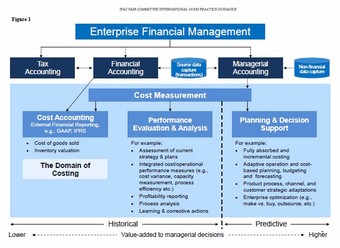
Differences between Financial and Managerial Accounting
This is a great image depicting the various differences in perspective found between different accounting methodologies. Looking at managerial accounting in this diagram, one can better understand its place in the organization.
Examples of Managerial Accounting
There are countless specific examples of managerial accounting practices. Taking a look at a few will provide additional scope and perspective on the field:
Throughput Accounting: Production processes have a great deal of inter-dependency. This can create opportunity costs, as interdependent resources are being restrained. Measuring the contribution per unit of constrained resource is called throughput accounting.
Lean Accounting: During the days when the Toyota Production System was just becoming celebrated as a leaner process, accountants began to consider the restrictions of traditional accounting methods on lean processes. As a result, managerial accounts began constructing a better way to measure just-in-time manufacturing process success.
Some simpler examples of common managerial accounting tasks include developing business metrics, cost-benefit analyses, IT cost transparency, life cycle cost analysis, strategic management advice, sales forecasting, geographically segmented reporting, and rate and volume analysis.
Managerial accounting is inherently flexible, and drives towards maximizing internal efficiency through careful consideration of opportunity costs and various customized metrics.
18.2.3: Financial Accounting
Financial accounting is a core organizational function in which accountants prepare a variety of documents to inform stakeholders of the financial health of operations.
Learning Objective
List the various expectations of a financial accounting statement, along with the three common statements produced
Key Points
- The role of financial accounting is of high importance, both for informing external stakeholders and for providing critical information to management.
- Financial accounting statements must be relevant, material, reliable, understandable, and comparable.
- The balance sheet measures all assets, liabilities, and stakeholder equity to identify and understand the organizations leverage position.
- The income statement is a top down statement, in which revenues are considered in the context of the costs and expenses required to obtain them. This ultimately demonstrates profitability.
- The statement of cash flows is all about liquidity, and identifying how much free cash is available to the organization for investment purposes.
- Taking all of these documents into account, stakeholders can derive a clear view of the health and efficiency of operation of a given organization.
Key Terms
- chronological
-
In order of time, usually earliest to latest.
- materiality
-
The state of being consequential in the making of a decision.
The Role of Financial Accounting
Financial accounting focuses on the tracking and preparation of financial statements for internal management and external stakeholders, such as suppliers, investors, government agencies, owners, and other interest groups. These financial statements are consistent with accounting guidelines and formatting, particularly for publicly traded organizations. This allows individuals unfamiliar with day to day operations to see the overall performance, health, and relative profitability of a given organization.
Characteristics of Financial Accounting
Generally speaking, it is expected by financial accounting standards that an organization maintain the following qualities when submitting financial accounting information:
- Relevance – Financial statements must be applicable to the decisions being made, and presented in a way that allows for distilling useful insights.
- Materiality – The information present must be of the quality that indicates consequence in strategic or legal decisions. This is to say that nothing of materiality should be omitted as well.
- Reliability – All information must be free of error, and reported with pinpoint accuracy.
- Understandability – Clarity and efficiency in presentation is important, as it must be immediately readable and without the possibility of being misinterpreted.
- Comparability – Finally, all presented financial statements should align with current best practices in accounting to ensure that the material presented is validly compared to that of other organizations.
How to Conduct Financial Accounting
Financial accountants are tasked with producing three primary documents that indicate a health check on various aspects (or at times all aspects) of the organization. These three statements are the balance sheet, the income statement, and the statement of cash flows.
Balance Sheet
A balance sheet demonstrates the overall value of organizational assets by listing current and long-term assets (fixed or otherwise) alongside short term and long term liabilities and stakeholder equity. Through balancing the assets against the combination of liabilities and stakeholder equity, the financial accounting should encounter a zero sum game.
Simply put: Assets = Liabilities + Shareholder Equity. This is the golden rule of balance sheets (hence the name: balance). The items on a balance sheet can range from long term debt to current inventory to dividends to accounts receivable to cash on hand. Anything and everything that can be valued should be included in this calculation.
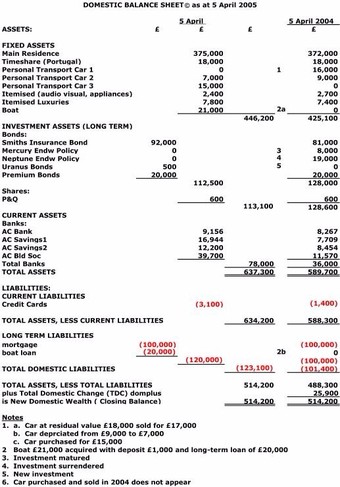
Balance Sheet Example
This balance sheet demonstrates such common line items an account will be populated and measuring when creating and releasing this financial statement.
Income Statement
As opposed to something that balances, the income statement is more of a one directional document. Picture this as a mathematical illustration of the organizations operations, from the production floor all the way to the hands of the consumer. When organizations go through such a process (producing, shipping, storing, paying taxes, selling, providing service, etc.), the expectation is that the price point established will cover all relevant costs while producing some percentage of net income. An income statement calculates whether or not a business is accomplishing this.
To picture it, let’s create a simple example. You own a pizza shop. You sold 1000 pizzas last month. Each pizza sold for $10 on average. That gives you $10,000, but this is your revenue, not your profit. For each pizza, it costs $4 in cheese, dough, sauce and toppings. That brings you down to $6,000. You have to pay your bills and your rent, which is takes you down another $2,000. Now, you’re at $4,000, and you end up paying $1,500 to your employees in wages. Of your $2,500 remaining, 40% goes to state and federal taxes. Your overall net income for the month is $1,500. This process is what an income statement does.
Statement of Cash Flows
The final statement is the statement of cash flows, which aims to identify how much capital in the organization is liquid (i.e. easily converted into spend). This is more of a chronological statement, as it takes the previous pay period and the current pay period, and identifies the difference in overall available cash.
The purpose of this document is quite interesting. An organizations available cash could be considered their flexibility in capturing external opportunities (e.g., investing in new opportunities, such as offering a new product or acquiring a competitor).
Combine these three documents, and stakeholders have a fairly clean view of what goes on in the organization. The balance of their assets, the overall profitability of their operations, and the availability of capital for expansion. This is the role of financial accountants.
18.2.4: Tax Accounting
Tax accounting couples legal obligations with financial accounting to ensure adherence to current tax laws.
Learning Objective
Understand the role of tax accounting in both small and large organizations
Key Points
- Every region has specific tax accounting rules and regulations. Adhering to these rules and regulations is critical to avoiding penalties and ensuring ethical behavior in the country (and/or state) of operation.
- Tax accountants act as a bridge between the organization and the governments that collect financial obligations. As a result, it requires a combination of financial and legal knowledge.
- On the financial side, tax accounts must understand the legal implications of decisions, as both opportunities and threats exist.
- On the legal side, the preparation, assessment, and delivery of tax documents is a time-sensitive and detail-oriented process that must be regularly maintained.
- Some unique situations exist in tax accounting, such as accounting for non-profit organizations (who don’t pay taxes). This still requires considerable legal know how and operational alignment with governmental regulations.
Key Term
- Tax accounting
-
The activity that focuses on satisfying legal accounting obligations through the preparation, analysis, and presentation of required tax documentation.
Tax accounting is relatively simple to explain, though nuanced in execution. In short, every region has specific tax accounting rules and regulations. Adhering to these rules and regulations is critical to avoiding penalties and ensuring ethical behavior in the country (and/or state) of operation. Tax accounting is therefore a combination of legal and financial knowledge.
The Financial Side
Tax accountants act as the bridge between an organization’s accounting team and the reporting bodies in the region. As a result, the primary role of a tax accountant is to understand the business’ current operating status, distill profitability before tax, and report earnings.
On the strategic side of this, tax accountants can consider any tax implications as it pertains to certain strategic decisions or tactics. Identifying and understanding opportunities in a region’s tax code is a win win. For example, some manufacturers can receive tax breaks for environmentally friendly operations, often high enough tax breaks to offset the cost of implementing them. Tax accountants should be aware of these opportunities in the legal environment.
The Legal Side
More tangibly, tax accounts will focus on the preparation, analysis, and presentation of tax payments and tax returns at all times. There are specialized accounting principles and obligations for each area of operation which must be met. Keeping up to date on what is expected, and ensuring alignment on across the organization, is their primary responsibility.
Some exceptions exist, of course, such as non-profit organizations. Non-profits have unique tax preparation requirements due to their no-tax status. This comes along with its fair share of obligations, paperwork, and approvals from the governing bodies.
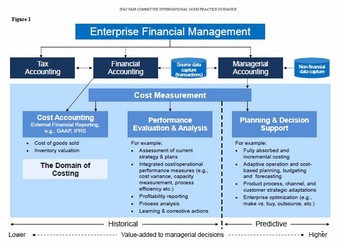
Various Accounting Perspectives
This image demonstrates the various responsibilities and perspectives of different forms of accounting (those being tax accounting, managerial accounting and financial accounting).
18.2.5: Government and Nonprofit Accounting
Governmental and nonprofit accounting follow different rules from those of commercial enterprises.
Learning Objective
Compare public vs. private accounting
Key Points
- Public sector entities have different goals to the private sector, who’s main goal is to make a profit. Public entities must be more fiscally responsible. The usage of government accounting processes also differs significantly from the use in the private sector.
- Publicly elected officials and their employees must be accountable to the public, and thus government accounting provides information on whether taxpayer funds are used responsibly or not.
- Government accounting must also serve the same purpose as commercial accounting, that is to provide information for decision-making purposes. The difference in this case is the recipient of the information is a government official, with different priorities and goals.
- Nonprofits also have unique accounting systems and standards. They generally use accrual basis accounting for their funds.
- Nonprofit financial statements generally include a balance sheet, a statement of activities or statement of support, a statement of functional expenses, and a cash flow statement.
Key Terms
- budget
-
An itemized summary of intended expenditure; usually coupled with expected revenue.
- Governmental accounting
-
Governmental accounting is an umbrella term which refers to the various accounting systems used by various public sector entities.
Public Sector Accounting
Governmental accounting is an umbrella term which refers to the various accounting systems used by various public sector entities. In the United States, for instance, there are two levels of government which follow different accounting standards set forth by independent, private sector boards. At the federal level, the Federal Accounting Standards Advisory Board (FASAB) sets forth the accounting standards to follow. Similarly, there is the Governmental Accounting Standards Board (GASB) for state and local level government .

Accounting
Governmental and Nonprofit accounting follow different rules to those of commercial enterprises.
Public vs. Private Accounting
There is an important difference between private sector accounting and governmental accounting. The main reasons for this difference is the environment of the accounting system. In the government environment, public sector entities have differing goals, as opposed to the private sector entities’ one main goal of gaining profit. Also, in government accounting, the entity has the responsibility of fiscal accountability which is demonstration of compliance in the use of resources in a budgetary context. In the private sector, the budget is a tool in financial planning and it is not mandatory to comply with it.
Government accounting refers to the field of accounting that specifically finds application in the public sector or government. The unique objectives of government accounting do not preclude the use of the double entry accounting system. There can, however, be other significant differences with private sector accounting practices, especially those that are intended to arrive at a net income result. Thus, a special field of accounting exists because:
- The objectives to which accounting reports to differ significantly from that for which generally accepted accounting practice has been developed for in the private (business) sector; and
- The usage of the results of accounting processes of government differs significantly from the use thereof in the private sector.
The objectives for which government entities apply accountancy can be organized in two main categories:
- The accounting of activities for accountability purposes. In other words, the representatives of the public, and officials appointed by them, must be accountable to the public for powers and tasks delegated. The public, who have no other choice but to delegate, are in a position that differs significantly from that of shareholders and therefore need financial information, to be supplied by accounting systems, that is applicable and relevant to them and their purposes.
- Decision-making purposes. The relevant role-players, especially officials and representatives, need financial information that is accounted, organized and presented for the objectives of their decision-making. These objectives bear, in many instances, no relation to net income results but are rather about service delivery and efficiency. The taxpayer, a very significant group, simply wants to pay as little taxes as possible for the essential services for which money is being coerced by law.
The governmental accounting system has a different focus for measuring accounting than private sector accounting. Rather than measuring the flow of economic resources, governmental accounting measures the flow of financial resources. Instead of recognizing revenue when they are earned and expenses when they are incurred, revenue is recognized when there is money available to liquidate liabilities within the current accounting period, and expenses are recognized when there is a drain on current resources.
Nonprofit Organizations
Nonprofit organizations generally use the following five categories of funds:
- Current fund – unrestricted. This fund is used to account for current assets that can be used at the discretion of the organization’s governing board.
- Current funds – restricted use current assets subject to restrictions assigned by donors or grantors.
- Land, building and equipment fund. Cash and investments reserved specifically to acquire these assets, and related liabilities, should also be recorded in this fund.
- Endowment funds are used to account for the principal amount of gifts the organization is required, by agreement with the donor, to maintain intact in perpetuity or until a specific future date or event.
- Custodian funds are held and disbursed according to the donor’s instructions.
18.2.6: Consumers of Accounting Information
Most of a company’s stakeholders consume its accounting information in one form or another.
Learning Objective
Explain the history of accounting
Key Points
- Double-entry bookkeeping first emerged in Northern Italy in the fourteenth century.
- As companies grew bigger, accounting standards were required for those without firsthand knowledge of operations to be able to understand the finances and operations of the company.
- Managers, employees, owners, and auditors all desire the information provided by management accounting.
- On the other hand, external auditors, potential and actual shareholders, creditors, analysts, economists, and government agencies rely on financial accounting statements to provide them with the information they need.
Key Terms
- IFRS
-
International Financial Reporting Standards (IFRS) are designed as a common global language for business affairs so that company accounts are understandable and comparable across international boundaries.
- GAAP
-
Generally Accepted Accounting Principles (GAAP) refer to the standard framework of guidelines for financial accounting used in any given jurisdiction; generally known as accounting standards.
Early accounts served mainly to assist the memory of the businessperson, and the audience for the account was the proprietor or record keeper alone. Cruder forms of accounting were inadequate for the problems created by a business entity involving multiple investors, so double-entry bookkeeping first emerged in northern Italy in the fourteenth century, where trading ventures began to require more capital than a single individual was able to invest.
The development of joint stock companies created wider audiences for accounts, as investors without firsthand knowledge of their operations relied on accounts to provide the requisite information. This development resulted in a split of accounting systems for internal (i.e., management accounting) and external (i.e., financial accounting) purposes and, subsequently, also in accounting and disclosure regulations and a growing need for independent attestation of external accounts by auditors.
Today, accounting is called “the language of business” because it is the vehicle for reporting financial information about a business entity to many different groups of people. Accounting that concentrates on reporting to people inside the business entity is called “management accounting” and is used to provide information to employees, managers, owner-managers, and auditors.
Management accounting is concerned primarily with providing a basis for making management or operating decisions. Accounting that provides information to people outside the business entity is called “financial accounting” and provides information to present and potential shareholders and creditors, such as banks or vendors, financial analysts, economists, and government agencies. Because these users have different needs, the presentation of financial accounts is very structured and subject to many more rules than management accounting. The body of rules that governs financial accounting in a given jurisdiction is the Generally Accepted Accounting Principles, or GAAP. Other rules include International Financial Reporting Standards, or IFRS, or U.S. GAAP.
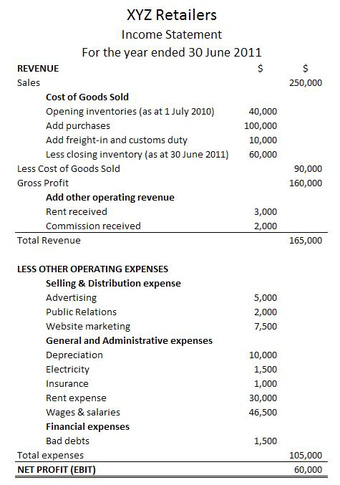
A Sample Income Statement
Expenses are listed on a company’s income statement.
18.3: The Accounting Process
18.3.1: The Accounting Equation
The accounting equation is a general rule used in business transactions where the sum of liabilities and owners’ equity equals assets.
Learning Objective
Break down the fundamental accounting equation
Key Points
- This equation is kept in balance after every business transaction. Everything falls under these three elements (assets, liability, owners’ equity) in a business transaction.
- Assets = Liabilities + Equity.
- The fundamental accounting equation is the foundation of the balance sheet.
Key Terms
- Accounting Equation
-
The “basic accounting equation” is the foundation for the double-entry bookkeeping system. For each transaction, the total debits equal the total credits.
- equity
-
Ownership interest in a company as determined by subtracting liabilities from assets.
- liabilities
-
An amount of money in a company that is owed to someone and has to be paid in the future, such as tax, debt, interest, and mortgage payments.
Example
- A company with $30,000 in liabilities and $10,000 in owners’ equity would have $40,000 in assets according to the accounting equation.
The fundamental accounting equation, which is also known as the balance sheet equation, looks like this:
. On the left side of the equation are the assets of the business, including cash, accounts receivable, notes receivable, property, plants, and equipment. Or more correctly, the term “assets” represents the value of the resources of the business.
On the right side of the equation are claims of ownership on those assets: liabilities are the claims of creditors (those “outside” the business); and equity, or owners’ equity, is the claim of the owners of the business (those “inside” the business). The fundamental accounting equation is kept in balance after every business transaction because everything falls under these three elements in a business transaction.
For example, when a company intends to purchase new equipment, its owner or board of directors has to choose how to raise funds for the purchase. Looking at the fundamental accounting equation, one can see how the equation stays is balance. If the funds are borrowed to purchase the asset, assets and liabilities both increase. If the company issues stock to obtain the funds for the purchase, then assets and equity both increase.
Additionally, changes is the accounting equation may occur on the same side of the equation. For example, if the company uses cash to purchase inventory, cash is decreased (credited) and inventory is increased (debited); thus, assets as a whole remain unchanged and the equation remains in balance. Likewise, as the company receives payment from its customers, accounts receivable is credited and cash is debited.
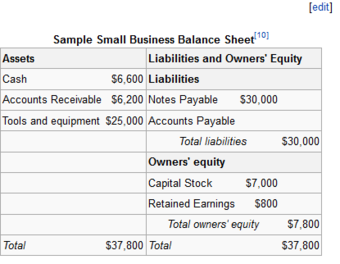
Sample Balance Sheet
A balance sheet shows how the accounting equation is applied.
18.3.2: Double-Entry Bookkeeping
A double-entry bookkeeping system requires that every transaction be recorded in at least two different nominal ledger accounts.
Learning Objective
Explain the fundamentals of accounting bookkeeping
Key Points
- In the double-entry accounting system, each accounting entry records related pairs of financial transactions for asset, liability, income, expense, or capital accounts.
- There are two different approaches to the double entry system of bookkeeping. They are Traditional Approach and Accounting Equation Approach.
- Recording of a debit amount to one account and an equal credit amount to another account results in total debits being equal to total credits for all accounts in the general ledger.
Key Terms
- debit
-
Debit and credit are the two fundamental aspects of every financial transaction in the double-entry bookkeeping system in which every debit transaction must have a corresponding credit transaction(s) and vice versa.
- debit card
-
a product that can be used to make payments by drawing money directly from the user’s bank account
Double-Entry Bookkeeping
A double-entry bookkeeping system is a set of rules for recording financial information in a financial accounting system in which every transaction or event changes at least two different nominal ledger accounts.
In the double-entry accounting system, each accounting entry records related pairs of financial transactions for asset, liability, income, expense, or capital accounts. Recording of a debit amount to one account and an equal credit amount to another account results in total debits being equal to total credits for all accounts in the general ledger. If the accounting entries are recorded without error, the aggregate balance of all accounts having positive balances will be equal to the aggregate balance of all accounts having negative balances. Accounting entries that debit and credit related accounts typically include the same date and identifying code in both accounts, so that in case of error, each debit and credit can be traced back to a journal and transaction source document, thus preserving an audit trail.
The “Golden Rules of Accounting”
The rules for formulating accounting entries are known as “Golden Rules of Accounting”. The accounting entries are recorded in the “Books of Accounts”. Regardless of which accounts and how many are impacted by a given transaction, the fundamental accounting equation A = L + OE (assets equals liabilities plus owner’s equity) will hold.
There are two different approaches to the double entry system of bookkeeping. They are the Traditional Approach and the Accounting Equation Approach. Irrespective of the approach used, the effect on the books of accounts remain the same, with two aspects (debit and credit) in each of the transactions.
Traditional Approach (British)
Following this approach, accounts are classified as real, personal, or nominal accounts. Real accounts are assets. Personal accounts are liabilities and owners’ equity and represent people and entities that have invested in the business. Nominal accounts are revenue, expenses, gains, and losses.
Transactions are entered in the books of accounts by applying the following golden rules of accounting:
- Personal account: Debit the receiver and credit the giver
- Real account: Debit what comes in and credit what goes out
- Nominal account: Debit all expenses & losses and credit all incomes & gains
Accounting Equation Approach (American)
Under this approach, transactions are recorded based on the accounting equation, i.e., Assets = Liabilities + Capital. The accounting equation is a statement of equality between the debits and the credits. The rules of debit and credit depend on the nature of an account. For the purpose of the accounting equation approach, all the accounts are classified into one of the following five types:
- Assets
- Liabilities
- Income/revenues
- Expenses
- Capital gains/losses
If there is an increase or decrease in one account, there will be an equal decrease or increase in another account. There may be equal increases to both accounts, depending on what kind of accounts they are. There may also be equal decreases to both accounts. Accordingly, the following rules of debit and credit in respect to the various categories of accounts can be obtained.
The rules may be summarized as below:
- Assets accounts: Debit increases in assets and credit decreases in assets
- Capital account: Credit increases in capital and debit decreases in capital
- Liabilities accounts: Credit increases in liabilities and debit decreases in liabilities
- Revenues or Incomes accounts: Credit increases in incomes and gains and debit decreases in incomes and gains
- Expenses or Losses accounts: Debit increases in expenses and losses and credit decreases in expenses and losses
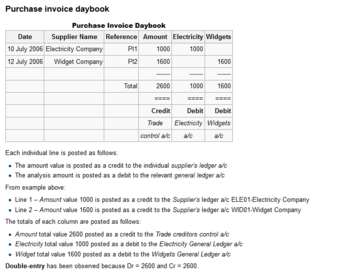
Example of Double entry bookkeping
Purchase Invoice Daybook
18.3.3: The Accounting Cycle
The accounting cycle includes analysis of transactions, transferring journal entries into a general ledger, revenue, and expense closed.
Learning Objective
Outline the accounting cycle from point of transaction to financial statements
Key Points
- When a transaction occurs, a document is produced. Most of the time these documents are external to the business, however, they can also be internal documents, such as inter-office sales. These documents are referred to as a source document.
- The Journal entries are then transferred to a Ledger. The group of accounts is called ledger, or a book of accounts. The purpose of a Ledger is to bring together all of the transactions for similar activity.
- Financial statements are drawn from the trial balance which may include: the Income statement, the Balance sheet, and the Cash flow statement.
- 3. prepare trial balance
- 4. post adjusting entries
- 5. prepare adjusted trial balance
- 6. prepare financial statements
- 7. post closing entries
- 8. prepare a post closing trial balance
Key Term
- Journal entries
-
A journal entry, in accounting, is a logging of transactions into accounting journal items. The journal entry can consist of several items, each of which is either a debit or a credit.
When a transaction occurs, a document is produced. Most of the time these documents are external to the business, however, they can also be internal documents, such as inter-office sales.
These documents are referred to as a source document. Some examples are: the receipt you get when you purchase something at the store, interest you earned on your savings account which is documented in your monthly bank statement, and the monthly electric utility bill that comes in the mail. These source documents are then recorded in a Journal. This is also known as a book of first entry. It records both sides of the transaction recorded by the source document. These write-ups are known as Journal entries.
These Journal entries are then transferred to a Ledger, which is the group of accounts, also known as a book of accounts. The purpose of a Ledger is to bring together all of the transactions for similar activity. For example, if a company has one bank account, then all transactions that include cash would then be maintained in the Cash Ledger. This process of transferring the values is known as posting. Once the entries have all been posted, the Ledger accounts are added up in a process called Balancing.
A particular working document called an unadjusted Trial balance is created. This lists all the balances from all the accounts in the Ledger. Notice that the values are not posted to the trial balance, they are merely copied. At this point accounting happens. The accountant produces a number of adjustments which make sure that the values comply with accounting principles. These values are then passed through the accounting system resulting in an adjusted Trial balance. This process continues until the accountant is satisfied.
Financial statements are drawn from the trial balance which may include: the Income statement, the Balance sheet, and the Cash flow statement.
Finally, all the revenue and expense accounts are closed.
18.4: The Balance Sheet
18.4.1: Defining the Balance Sheet
The balance sheet is a summary of the financial balances of a company.
Learning Objective
Explain the fundamental elements of the balance sheet
Key Points
- The balance sheet is often described as a snapshot of a company’s financial condition.
- Unlike the other basic financial statements, the balance sheet only applies to a single point in time of the calendar year.
- It shows the assets, liabilities, and ownership equity of the company, and allows for an analysis of the company’s financial health.
Key Terms
- balance sheet
-
A summary of a person’s or organization’s assets, liabilities and equity as of a specific date.
- calendar year
-
The amount of time between corresponding dates in adjacent years in any calendar.
The Balance Sheet
In financial accounting, a balance sheet is a snapshot of a company’s (sole proprietorship, a business partnership, a corporation, or other business organization, such as an LLC or an LLP) financial situation. Assets, liabilities, and ownership equity are listed as of a specific date, such as the end of the company’s financial year. Of the four basic financial statements, the balance sheet is the only statement which applies to a single point in time of a business’ calendar year. A standard company balance sheet has three parts: assets, liabilities, and ownership equity. The main categories of assets are usually listed first, and typically in order of liquidity. Assets are followed by the liabilities. The difference between the assets and the liabilities is known as the equity (or the net assets, or the net worth, or capital) of the company, and according to the accounting equation, net worth must equal assets minus liabilities.
Another way to look at the same equation is that assets equals liabilities plus owner’s equity. Looking at the equation in this way shows how assets were financed: either by borrowing money (liability) or by using the owner’s money (owner’s equity). Balance sheets are usually presented with assets in one section and liabilities and net worth in the other section with the two sections “balancing. “
A business operating entirely in cash can measure its profits by withdrawing the entire bank balance at the end of the period, plus any cash in hand. However, many businesses are not paid immediately; they build up inventories of goods and they acquire buildings and equipment. In other words: businesses have assets and so they cannot, even if they want to, immediately turn these into cash at the end of each period. Often, these businesses owe money to suppliers and to tax authorities, and the proprietors do not withdraw all their original capital and profits at the end of each period. In other words, businesses also have liabilities.
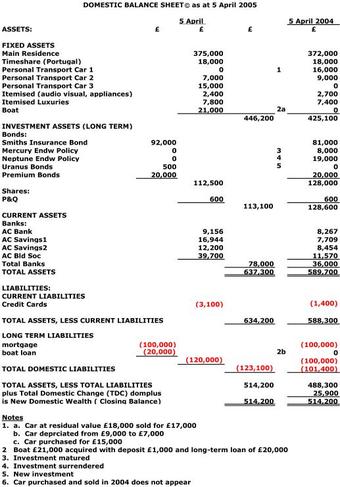
Example Domestic Balance Sheet
This balance sheet shows the company’s assets, liabilities, and shareholder equity.
18.4.2: Assets
Assets are resources as a result of past events and from which future economic benefits are expected to flow to the enterprise.
Learning Objective
Define assets in financial accounting
Key Points
- Anything tangible or intangible that can be owned to produce positive economic value is considered an asset. Examples are cash, inventory, machinery, etc.
- Assets are recorded on the balance sheet. The accounting equation relating assets, liabilities, and owners’ equity is: Assets = Liabilities + Owners’ Equity.
- Tangible assets are actual physical assets, and include both current and fixed assets. Examples are inventory, buildings, and equipment.
- Intangible assets are nonphysical resources which give the firm an advantage in the marketplace. Examples are copyrights, computer programs, financial assets, and goodwill.
Key Terms
- International Accounting Standards Board
-
The independent, accounting standard-setting body of the International Financial Reporting Standards Foundation.
- tangible asset
-
Any asset, such as buildings, land, equipment etc., that has physical form.
- intangible asset
-
Any valuable property of a business that is not does not appear on the balance sheet, including intellectual property, customer lists, and goodwill.
In financial accounting, assets are economic resources. Anything tangible or intangible that is capable of being owned or controlled to produce value and that is held to have positive economic value is considered an asset.
Simply stated, assets represent ownership of value that can be converted into cash (although cash itself is also considered an asset). The balance sheet of a firm records the monetary value of the assets owned by the firm . It is money and other valuables belonging to an individual or business. Two major classes are tangible assets and intangible assets .
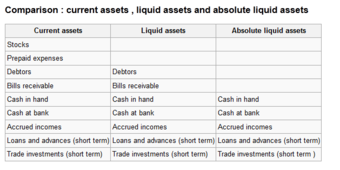
Comparison of Various types of Assets
Current assets vs. liquid assets vs. absolute liquid assets.
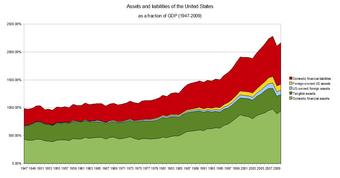
Assets and Liabilities of the US
Assets and liabilities of the US as a fraction of the GDP 1945-2009.
Tangible assets contain various subclasses, including current and fixed assets. Current assets include inventory, while fixed assets include such items as buildings and equipment.
Intangible assets are nonphysical resources and rights that have a value to the firm because they give the firm some kind of advantage in the market place. Examples of intangible assets are goodwill, copyrights, trademarks, patents, computer programs, and financial assets, including such items as accounts receivable, bonds and stocks.
The accounting equation relates assets, liabilities, and owner’s equity:
Assets = Liabilities + Stockholders’ Equity (Owners’ Equity)
That is, the total value of a firm’s assets are always equal to the combined value of its “equity” and “liabilities. ” In other words, the accounting equation is the mathematical structure of the balance sheet.
Probably the most accepted accounting definition of asset is the one used by the International Accounting Standards Board. The following is a quotation from the IFRS Framework:
“An asset is a resource controlled by the enterprise as a result of past events and from which future economic benefits are expected to flow to the enterprise. “
18.4.3: Liabilities
A “liability” is an obligation of an entity, the settlement of which may result in the yielding of economic benefits in future.
Learning Objective
Define liabilities in financial accounting
Key Points
- Liabilities in financial accounting need not be legally enforceable, but can be based on equitable obligations or constructive obligations.
- Liabilities on the balance sheet are split into two categories: current liabilities, and long-term liabilities.
- Current liabilities are those expected to be liquidated within a year.
- Long-term liabilities are those which will not be liquidated in the coming year.
Key Terms
- current liabilities
-
In accounting, current liabilities are often understood as all liabilities of the business that are to be settled in cash within the fiscal year, or the operating cycle of a given firm, whichever period is longer.
- liabilities
-
An amount of money in a company that is owed to someone and has to be paid in the future, such as tax, debt, interest, and mortgage payments.
Examples
- Examples of long-term liabilities include long-term bonds, leases, pension obligations, and debentures.
- Examples of current liabilities include wages, taxes, accounts payables, and short-term obligations (such as purchase from suppliers).
In financial accounting, a liability is defined as an obligation of an entity arising from past transactions or events, the settlement of which may result in the transfer or use of assets, provision of services or other yielding of economic benefits in the future. A liability is defined by the following characteristics:
- Any type of borrowing from persons or banks for improving a business or personal income that is payable during short or long time
- A duty or responsibility to others that entails settlement by future transfer or use of assets, provision of services, or other transaction yielding an economic benefit, at a specified or determinable date, on occurrence of a specified event, or on demand
- A duty or responsibility that obligates the entity to another, leaving it little or no discretion to avoid settlement
- A transaction or event obligating the entity that has already occurred
Liabilities in financial accounting need not be legally enforceable, but can be based on equitable obligations or constructive obligations. An equitable obligation is a duty based on ethical or moral considerations. A constructive obligation is an obligation that is implied by a set of circumstances in a particular situation, as opposed to a contractually based obligation. Examples of types of liabilities include money owing on a loan, money owing on a mortgage, or an IOU. Liabilities are debts and obligations of the business they represent that creditors claim on business assets. Liabilities are reported on a balance sheet and are usually divided into two categories:
- Current liabilities: these liabilities are reasonably expected to be liquidated within a year. They usually include payables such as wages, accounts, taxes, and accounts payables, unearned revenue when adjusting entries, portions of long-term bonds to be paid this year, short-term obligations (e.g., from purchase of equipment).
- Long-term liabilities: these liabilities are reasonably expected not to be liquidated within a year. They usually include issued long-term bonds, notes payables, long-term leases, pension obligations, and long-term product warranties.
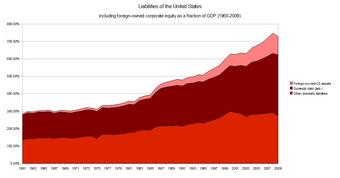
Liabilities of the United States
Liabilities of the United States as a fraction of GDP (1960-2009)
18.4.4: Owners’ Equity
Shareholders’ equity is the difference between total assets and total liabilities.
Learning Objective
Define owners’ equity
Key Points
- Shareholders’ equity tells you the “book value”, i.e., what is left over for shareholders after the company has paid off all its debt.
- Shareholders’ Equity = Total Assets – Total Liabilities.
- If liabilities exceed assets, then negative equity exists.
- Ownership equity may include both tangibles and intangibles, such as intellectual property or goodwill.
Key Terms
- capital surplus
-
A balance sheet item under shareholders’ equity. Increases by the value above an original par value per share that newly-issued shares are sold for.
- shareholders’ equity
-
The remaining interest in assets of a company, spread among individual shareholders of common or preferred stock.
- owners’ equity
-
the remaining interest in all assets after all liabilities are paid
- equity financing
-
funding obtained through the sale of ownership interests in the company
Example
- Ownership equity may include common stock, preferred stock, retained earnings, treasury stock, and reserve.
In accounting and finance, equity is the residual claim or interest of the most junior class of investors in assets, after all liabilities are paid. If liability exceeds assets, negative equity exists.
In an accounting context, shareholders’ equity (or stockholders’ equity, shareholders’ funds, shareholders’ capital or similar terms) represents the remaining interest in assets of a company, spread among individual shareholders of common or preferred stock.
At the start of a business, owners put some funding into the business to finance operations. This creates a liability on the business in the shape of capital as the business is a separate entity from its owners. Businesses can be considered, for accounting purposes, sums of liabilities and assets. After liabilities have been accounted for, the positive remainder is deemed the owners’ interest in the business.
This definition is helpful in understanding the liquidation process in case of bankruptcy. At first, all the secured creditors are paid against proceeds from assets. Afterward, a series of creditors, ranked in priority sequence, have the next claim/right on the residual proceeds. Ownership equity is the last or residual claim against assets, settled only after all other creditors are paid. In such cases where even creditors could not get enough money to pay their bills, nothing is left over to reimburse owners’ equity; which is thus reduced to zero. Ownership equity is also known as risk capital or liable capital.
In financial accounting, equity capital is the owners’ interest on the assets of the enterprise after deducting all its liabilities. It appears on the balance sheet/statement of financial position, one of the four primary financial statements. Ownership equity includes both tangible and intangible items (such as brand names and reputation/goodwill). Accounts listed under ownership equity include (for example):
- Share capital (common stock)
- Preferred stock
- Capital surplus
- Retained earnings
- Treasury stock
- Stock options
- Reserve
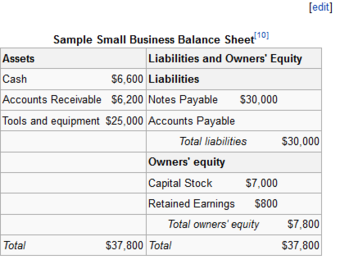
Sample Balance Sheet
Sample of a small business’s balance sheet, showing owners’ equity.
18.5: The Income Statement
18.5.1: Defining the Income Statement
The income statements reports the revenues, expenses, and overall net profit or loss over a given reporting period.
Learning Objective
Define the income statement in the broader context of financial accounting
Key Points
- The income statement ultimately provides insights on profitability through tracking revenues and the expenses incurred to gain those revenues.
- The income statement starts with revenues, which represent the overall incoming proceeds from sales of products and/or services.
- The cost of the goods sold, alongside the selling and general administrative costs, depreciation, and R&D are subtracted from those revenues as expenses.
- Non-operating items such as taxes, cost of financing, and other sources of miscellaneous revenues or expenses are calculated after that.
- This results in the net income or loss over the given reporting period. Dividing the net income by overall sales will provide the organization’s profit margin.
Key Terms
- Profitability
-
The capacity to produce capital, in this context through organizational operations.
- depreciation
-
The decline in value of assets.
What is an Income Statement
The income statement is one of the main financial statements all publicly traded organizations around the world generate on an regular basis as a reporting tool for stakeholders and the general public. The creation and maintenance of these statements is the primary responsibility of financial accountants.
The income statement (also referred to as a profit and loss account, or a profit and loss statement) answers some core questions regarding profitability and the overall utilization of raw materials to generate revenue exceeding the expenses involved. The income statement is therefore a linear assessment, starting with revenue and ending with net gains or losses, of the overall costs of a given production process. As a result, this statement is intrinsically describing a span of operational time, and the transformation of revenues into profits or losses over that given time period.

Wikimedian’s Income Statement
Understanding an income statement is best accomplished by analyzing one. The above income statement is pulled directly from Wikipedia, and is the financial information they are offering to external stakeholders and the general public. The income statement starts with revenues, minuses costs and expenses, and results in a net gain or loss.
Why They Are Useful
The income statement is a critically useful tool, particularly for product managers, strategists, operational specialists, and investors. In short, incomes statements are useful because they demonstrate an organization’s ability to turn revenues into usable cash flows (which will then be inserted into a cash flow statement on an ongoing basis). Profitability of operations is the key concept here, and it is a critical component of organizational success.
How To Create an Income Statement
As a financial accountant, understanding the inputs of an income statement is key to developing accurate and useful reports. Incomes statements can loosely be divided into the following subcategories:
Revenue
At the top, an organization should report overall revenue. The primary input here will be overall proceeds from sales, though the appreciation of assets or the acquisition of accounts receivable owed from a previous reporting period may also add to this number.
Expenses
Expenses are the overall costs of acquiring the above revenues. This can be divided into a few categories:
- Cost of Goods Sold (COGS) – All costs in material, labor, and overhead that are directly required for the production and/or manufacturing of a given good.
- Selling and General Administration (SG&A) – These costs are support costs, such as the salaries of HR staff, management, legal, accounting, marketing, and other broader corporate expenses that benefit the sale of a particular good.
- Depreciation/Amortization – Over time, fixed assets will decrease in value. This depreciation of assets is allocated as an expense over the lifetime of the assets being recorded.
- Research and Development (R&D) – Investment in the research and development of revenue-generating products will also be a business expense for the income statement.
Non-Operating Items
Other gains or losses, such as those from rent, income, patents, foreign exchange, goodwill, etc., should be included as unusual gains or losses. Financial costs from borrowing capital and taxes due will also be included in this section. An additional section of irregular items is added if necessary (though rarely), which could pertain to changing business locations (quite costly), discontinuing operations, or other unique scenarios that need to be reported but don’t fit cleanly in any given line item.
Net Income
After all of the items have been added or subtracted accordingly from the starting revenue, the income statement will display the overall net income or net loss. This is where investors and stakeholders derive profit margin: net income/revenue. This margin of profitability is a useful input for the overall value of an organization’s operational efficiency.
18.5.2: Revenues
Revenue is cash inflows or other enhancements of assets derived by delivering or producing goods.
Learning Objective
Explain how revenue is used to determine the health of a company
Key Points
- Revenue is a calculation or estimation of periodic income based on a particular standard accounting practice or the rules established by a government or government agency.
- In general usage, revenue is income received by an organization in the form of cash or cash equivalents. Sales revenue is income received from selling goods or services over a period of time. Tax revenue is income that a government receives from taxpayers.
- Revenue is a crucial part of financial statement analysis. A company’s performance is measured by the extent to which its asset inflows (revenues) compare with its asset outflows (expenses).
- Revenue is used as an indication of earnings quality. There are several financial ratios attached, the most important being gross margin and profit margin. In addition, companies use revenue to determine bad debt expense using the income statement method.
Key Terms
- cash budget
-
a prediction of future money receipts and expenditures for a particular time period
- Cash inflows
-
Cash inflows are the movement of money into a business, project or financial product.
Examples
- Lending businesses like car rentals and banks receive most of their revenue from fees and interest generated by lending assets to other organizations or individuals.
- For some businesses, such as manufacturing and/or grocery, most revenue is from the sale of goods.
Revenue is cash inflows or other enhancements of assets during a period from delivering or producing goods, rendering services or other activities that constitute an entity’s ongoing major operations. It is usually presented as sales minus sales discounts, returns and allowances.
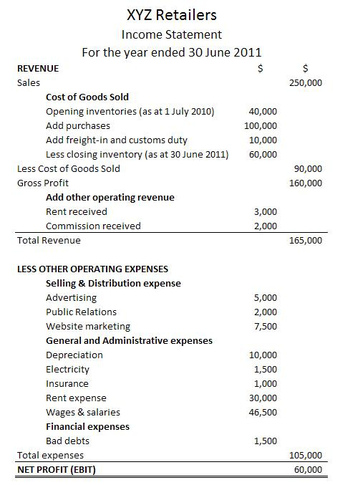
A Sample Income Statement
Expenses are listed on a company’s income statement.
In business, revenue is income that a company receives from its normal business activities, usually from the sale of goods and services to customers. Every time a business sells a product or performs a service, it obtains revenue. This is referred to as gross revenue or sales revenue.
In the United Kingdom and other countries, revenue is referred to as turnover. Some companies receive revenue from interest, dividends or royalties paid to them by other companies. Revenue may refer to business income in general or the amount, in a monetary unit, received during a period of time. For example, “Last year, Company X had revenue of $42 million. “
Revenue is a crucial part of financial statement analysis, and the income statement in particular. A company’s performance is measured to the extent to which its asset inflows (revenues) compare with its asset outflows (expenses). Net Income is the result of this equation. Consistent revenue growth, as well as net income growth, is considered essential for a company’s publicly traded stock to be attractive to investors. Revenue is used as an indication of earnings quality. There are several financial ratios attached to it, the most important being gross margin and profit margin. In addition, companies use revenue to determine bad debt expense using the income statement method.
18.5.3: Cost of Goods Sold
The cost of goods sold, calculated and recorded in the income statement, is a useful indicator of overall production costs and efficiency.
Learning Objective
Understand how to calculate COGS under various recording methods, and recognize the value of this calculation strategically in terms of production efficiency
Key Points
- Calculated and recorded on the income statement, the cost of goods sold (COGS) indicates the overall production efficiency on a unit to unit basis.
- COGS is a relevant indicator of potential profitability when used as a benchmark to the consumer willingness to pay and overall price point of the goods being sold.
- COGS includes the cost of sourcing raw materials, labor directly required for production, overhead applicable to production, warehousing, and shipping.
- Various approaches can be taken from an accounting perspective in order to record and report COGS. This includes LIFO, FIFO, average cost, and specific identification.
Key Terms
- homogeneous
-
Having the same composition throughout.
- overhead
-
The expense of a business not directly assigned to goods or services provided.
The Importance of COGS
The cost of goods sold (COGS) is a highly relevant indicator for the health of business operations, as it is a variable cost directly applied to each item sold on a per unit basis. This calculation allows the business to see just how much it costs to source, product, inventory, manage, and distribute organizational products and services. From a general strategic point of view, the COGS when compared to the consumer willingness to pay is the key indication of whether or not the production of a certain product (at a certain volume) will yield long-term sustainable profits.
How COGS is Derived
When viewing an income statement, it is useful to recall that the flow of information is top-down. At the top of the income statement is overall revenues, which are immediately applied to the cost of goods sold. This initial calculation will take into account the following costs of production:
- Sourcing of raw materials, parts and supplies used
- All labor directly involved in the production, manufacturing, and delivery of the product/service, including the benefits and payroll taxes
- All overhead directly applicable to the production process (i.e. electricity to run machines, rent for the manufacturing facility, rent for the warehouses, salaries of factory management, etc.)
- All storage and warehousing of products/services, alongside the distribution to consumers (i.e. shipping, storing, handling)
In short, COGS refers to the cost of producing the good from start to finish. This does NOT include support activities such as corporate marketing, corporate HR, senior management (unless they are actively on the production floor), IT infrastructure (unless directly integrated with manufacturing) and other sales, general, and administrative costs.

Break-even Point
The cost of goods sold often determines at what level of output (in terms of units) will produce a break-even point at the given price point the item is being sold.
Recording Methodologies
When applying this information to the income statement, different accounting tactics are used depending upon the situation of the organization. A few key record keeping concepts to keep in mind when approaching COGS:
First-In, First-Out (FIFO) – Under this COGS tracking method, the first items to be produced are the ones that are sent off the shelves first. Picture a smartphone manufacturer, where the first 50 cost $200 to produce and the second 50 cost $300 to produce. After selling the first 50 phones, the COGS under FIFO would be $10,000 (50 x $200).
Last-In, First-Out (LIFO) – Under this COGS method, the last items produced are the ones that are sent off the shelves first. So, to use the above example, the sale of the first 50 phones would have a recorded COGS of $15,000 (50 x $300).
Average Cost – Under this COGS method, the overall per unit production cost is averaged across the entire recording period. That is to say that the total COGS per unit will simply be the overall cost of all operations (during reporting period)/production volume (during reporting period). This is particularly helpful for homogeneous goods.
Specific Identification – As an antithesis to average cost calculations, this method tracks each individual item and prices the COGS according to its individual production process. This can be valuable when producing specialized and differentiated goods, which don’t always sell at the same price or compare cleanly to one another.
18.5.4: General and Administrative Expenses (G&A)
General and administrative non-production related costs provide a good indication of overall operational efficiency.
Learning Objective
Understand SG&A expenses and what they indicate about an organization
Key Points
- SG&A expenses are expressed on the income statement under operating expenses and refer to non-production related operating costs.
- SG&A costs are (relatively) fixed, and therefore they are a useful indication of efficiency when viewed as a percentage of overall revenues.
- Key items under SG&A include salary, rent, utilities, software, insurance, and a wide variety of other administrative and overhead-related costs.
- When viewing SG&A in the context of the organization and the competition, creating efficiency in spending relative to scale of production is a primary objective.
Key Term
- expenditures
-
Costs to be paid out. From an accounting perspective, these are credited costs on a given line item.
Why SG&A Costs are Relevant
In reporting expenses on an income statement, there are various expenses incurred that are not directly related to production. The primary reason tracking these expenses separately is so important is because they are independent of variable production volume, and as a result, their overall impact on the organization is largely fixed (as opposed to variable, per unit cost). This has some strategic implications.
How SG&A Costs are Calculated
Most of these expenses tend to revolve around indirect aspects of production. One way to picture this is to consider the supporting infrastructure around the core process: the office space (and the associated utility costs), for example, or the salaries of support staff and management. While the potential list of expenditures for this line item is extensive, the following are some common expenses incurred that would be filed under SG&A:
- Salary/Payroll (i.e. salary not directly related to variable production)
- Overhead
- Administration
- Software
- Rent
- Insurance
- Maintenance
- Commissions
- Utilities
What SG&A Implies
By separating these expenses from the production expenses, it provides investors, management, and other stakeholders with insights surrounding the efficiency of organizational operation. Organizations with an SG&A budget that represents a high percentage of their overall expense would be assumed to be less efficient than a similar organization producing a similar amount of revenue with a lower SG&A.
For example, company A has quite a few highly paid managers and executives on their team. They also use cutting edge software to manage the production process, which has a high annual cost. They produce slightly more revenue than their close competitor, company B (20% more revenue per annum). They create a net income of 2% on an annual basis.
Company B, on the other hand, has few managers and executives and relies on a slightly slower yet much cheaper software solution for managing operational output. As a result, they make 20% less than company A each year, but their expenses are 40% less than company. As a result, the produce a net income at almost 30% of revenue.
Company A is clearly producing more volume and making bigger strategic investments in IT, however company B is leveraging their resources better in terms of profitability by minimizing their SG&A and focusing more exclusive on investing in their production efficiency.
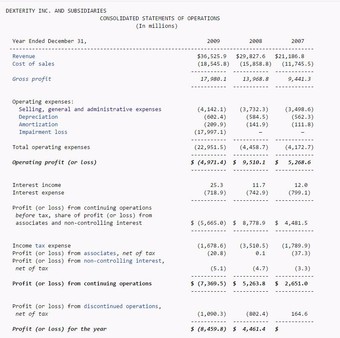
Income Statement
This image shows a basic income statement, including a line item for SG&A. This demonstrates where it is (under operating expenses).
18.5.5: Net Income
Net income in accounting is an entity’s income minus expenses for an accounting period.
Learning Objective
Define Net Income
Key Points
- Net income can be distributed among holders of common stock as a dividend or held by the firm as an addition to retained earnings.
- Net earnings and net profit are commonly found as synonyms for net income. Often, the term “income” is substituted for net income, yet this is not preferred due to the possible ambiguity.
- Net income can be distributed among holders of common stock as a dividend or held by the firm as an addition to retained earnings.
Key Terms
- minority interest
-
In accounting, minority interest (or non-controlling interest) is the portion of a subsidiary corporation’s stock that is not owned by the parent corporation.
- Common stock
-
Shares of an ownership interest in the equity of a corporation or other entity with limited liability entitled to dividends, with financial rights junior to preferred stock and liabilities.
Net income in accounting is an entity’s income minus expenses for an accounting period. It is computed as the residual of all revenues and gains over all expenses and losses for the period and has also been defined as the net increase in stockholder’s equity that results from a company’s operations. Net income is a distinct accounting concept from profit. Profit is a term that means different things to different people, and different line items in a financial statement may carry the term “profit,” such as gross profit and profit before tax. In contrast, net income is a precisely defined term in accounting.
Often, the term income is substituted for net income, yet this is not preferred due to the possible ambiguity. Net income is informally called the “bottom line,” because it is typically found on the last line of a company’s income statement (a related term is “top line,” meaning revenue, which forms the first line of the account statement). The items deducted will typically include tax expense, financing expense (interest expense), and minority interest.Likewise, preferred stock dividends will be subtracted too, though they are not an expense. For a merchandizing company, subtracted costs may be the cost of goods sold, sales discounts, and sales returns and allowances. For a product company advertising, manufacturing, and design and development costs are included.
Net income can be distributed among holders of common stock as a dividend or held by the firm as an addition to retained earnings. As profit and earnings are used synonymously for income (also depending on United Kingdom and U.S. usage), net earnings and net profit are commonly found as synonyms for net income. Often, the term “income” is substituted for net income, yet this is not preferred due to the possible ambiguity.
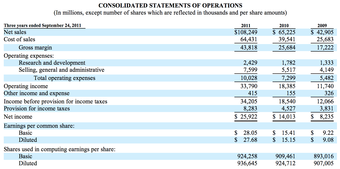
Apple Inc’s Income Statement
Apple’s revenues and net income rose greatly in 2011.
An equation for net income:
Net sales (revenue) – Cost of goods sold = Gross profit – SG&A expenses (combined costs of operating the company) = EBITDA – Depreciation & amortization = EBIT – Interest expense (cost of borrowing money) = EBT – Tax expense = Net income (EAT)
18.5.6: Sample Income Statement
The income statement displays the revenues recognized for a specified period and the costs and expenses charged against these revenues.
Learning Objective
Explain the uses and components of an income statement
Key Points
- The purpose of the income statement is to show managers and investors whether the company made or lost money during the reported period.
- An income statement differs from a balance sheet in that it represents a period of time as opposed to a single moment.
- Income statements should help investors and creditors determine the past financial performance of the enterprise, predict future performance, and assess the capability of generating future cash flows through reporting the income and expenses.
Key Terms
- depreciation
-
The measurement of the decline in value of assets. Not to be confused with impairment, which is the measurement of the unplanned, extraordinary decline in value of assets.
- goodwill
-
The value of a business entity not directly attributable to its tangible assets and liabilities. This value derives from factors such as consumer loyalty to the brand.
- income statement
-
a calculation which shows the profit or loss of an accounting unit during a specific period of time, providing a summary of how the profit or loss is calculated from gross revenue and expenses
Income Statements
The income statement (profit and loss statement), is a company’s financial statement indicating how revenue becomes net income. ‘Revenue’ is money received from the sales of products and services before expenses are deducted, also called the ‘top line. ‘ The net income is the result after all revenues and expenses have been accounted for, also known as the ‘net profit’ or the ‘bottom line. ‘ The income statement displays the revenues recognized for a specified period and the expenses charged against these revenues, including write-offs (depreciation and amortization of assets) and taxes. The purpose of income statements is showing managers and investors whether companies made profits or losses during those periods. An income statement differs from a balance sheet because it represents a period of time, not a single moment.
Preparing the income statement involves two possible methods. The Single Step income statement takes a simpler approach, adding revenues and subtracting expenses to find the bottom line. The more complex Multi-Step income statement takes several steps to find the bottom line, starting with the gross profit. It then calculates operating expenses which, when deducted from the gross profit, yield ‘income from operations. ‘ The difference of other revenues and expenses is then applied to the income from operations. When combined with ‘income from operations,’ this yields ‘income before taxes. ‘ The final step is to deduct taxes, which finally produces the net income for the period measured.
Usefulness and Limitations
Income statements should help investors and creditors determine the past financial performance of the enterprise, predict future performance, and assess the capability of generating future cash flows through income and expense reports. However, income statements have several limitations:
- Items that might be relevant but cannot be reliably measured are not reported (brand recognition and loyalty).
- Some numbers depend on the accounting methods used (using FIFO or LIFO accounting to measure inventory level).
- Some numbers depend on judgments and estimates (depreciation expense depends on estimated useful life and salvage value).
Components
Operating Section
Revenue: Cash inflows or other enhancements of an entity’s assets during periods of delivering or producing goods, rendering services, or other activities constituting the ongoing major operations. It is usually presented as sales minus discounts, returns, and allowances. Every time a business sells a product or performs a service, it obtains revenue, which is often referred to as ‘gross’ or ‘sales revenue. ‘
Expenses: Cash outflows, consumption of assets, or incurrence of liabilities during a period from delivering or producing goods, rendering services, or carrying out other activities constituting the entity’s ongoing major operations.
Cost of Goods Sold (COGS) / Cost of Sales: Represents the direct costs attributable to goods produced and sold by a business (manufacturing or merchandizing), including material costs, direct labour, and overhead costs. It excludes operating costs such as selling, administration, advertising, or R&D.
Selling, General and Administrative expenses (SG&A or SGA): Consists of the combined payroll costs. SGA is usually understood as a major portion of non-production costs, in contrast to production costs like direct labor.
Selling Expenses: Represents expenses needed to sell products (salaries of salespeople, commissions and travel expenses, advertising, freight, shipping, depreciation of sales, store buildings and equipment, et cetera).
General and Administrative (G&A) Expenses: Represents expenses necessary to manage the business (salaries of officers or executives, legal and professional fees, utilities, insurance, depreciation of office buildings and equipment, office rents, office supplies, et cetera).
Depreciation / Amortization: The charge with respect to fixed or intangible assets that have been capitalized on the balance sheet for a specific accounting period. It is a systematic and rational allocation of cost, not the recognition of market value decrement.
Expenses recognised in the income statement should be analysed either by nature (raw materials, transport costs, staffing costs, depreciation, employee benefit) or by function (cost of sales, selling, administrative).
Non-Operating Section
Other revenues or gains: Revenues and gains from non-primary business activities (rent, patent income, goodwill). It also includes gains that are either unusual or infrequent, but not both (gain from sale of securities or gain from fixed asset disposal).
Other expenses or losses: Expenses or losses not related to primary business operations (foreign exchange loss).
Finance costs: Costs of borrowing from various creditors (interest expenses, bank charges).
Income tax expense: Sum of the amount of tax payable to tax authorities in the current reporting period (current tax liabilities/tax payable) and the amount of deferred tax liabilities or assets.
Irregular Items
These are reported separately so that stakeholders can better predict future cash flows: irregular items probably won’t recur. They are reported net of taxes. Discontinued operation is the most common type of irregular item. Shifting business locations, stopping production temporarily, or changes due to technological improvement do not qualify as discontinued operations, which must be shown separately.
18.6: The Statement of Cash Flows
18.6.1: The Imperative of Liquidity
Organizations must carefully manage their cash flow statements to ensure appropriate liquidity to avoid missing investment opportunities.
Learning Objective
Consider the concept of liquidity as it pertains to an organization’s available cash flow and overall ability to capture opportunities in the market
Key Points
- Understanding a cash flow statement requires an understanding of the time value of money, the risk and return of certain investments, and the liquidity of existing capital.
- Differentiating between different investment opportunities based on liquidity can help ensure that cash flow will be available exactly when it is needed.
- When looking at overall cash flow, liquidity risk should be avoided through diversification.
Key Terms
- liquidity risk
-
The risk that an asset, security, or commodity is not easily converted in cash without impacting the price of sale.
- liquidity
-
The degree to which something is in demand and easily recovered, making it easily convertible to cash.
Why Liquidity Matters
To accurately frame the discussion of cash flows, an understanding of liquidity is integral. Having cash on hand is a seemingly simple concept. If I have capital, I can spend it. For businesses, however, it is quite a bit more complex. Cash flows must take into account not only amounts of capital, but the time value and availability of said capital.
When an organization has an opportunity to fund, or a debt to pay, they need capital on hand (i.e. capital available now) to provide funding. While an organization may have a great deal of value, this does not mean that said value equates to usable capital.
Let’s take an example. Company A and Company C want to purchase a new manufacturing machine from Company B. However, Company B will sell at their determined price to the first company with the capital to pay. Capital A has the majority of their money wrapped up in inventory (i.e. holding products for sale) which they expect to sell within 4 weeks, while Company C has their capital in a savings account. Company C will capture the opportunity, as the capital they are using is more liquid.

Liquidity
This chart shows some estimations of various types of capital investments, alongside their respective risk, return, and liquidity.
Liquidity Risk
When considering cash flow, it is important to understand liquidity risk. The difficulty in taking a certain asset to market, and recovering capital without incurring a loss of value, is called liquidity risk. When looking at overall cash flow, it’s important to consider how easily the available assets and investments are converted into capital to capture external opportunities.
All investments of capital can be framed with three key attributes: average expected return, degree of risk, and overall liquidity. Business managers and accountants, when considering their investment options, should keep liquidity in mind at all times. Conversely, having cash sitting without investment also incurs an opportunity cost. Inflation generally devalues any cash asset, and investing capital into money markets can generate interest. The decision of how much cash to invest, and where to invest it, is therefore a key consideration when balancing accounts for an organization.
18.6.2: Direct and Indirect Measurement
Cash flow statements can be measured via the direct method and the indirect method to determine overall liquidity.
Learning Objective
Differentiate between the direct and indirect methods of cash flow accounting, with a particular focus on the more popular indirect method
Key Points
- Statements of cash flow allow internal and external stakeholders to understand an organization’s overall liquidity, and what is presently available for utilization.
- Understanding cash flows is critical to capturing short-term opportunities and investments, while also acting as a health check for overall operational output over a given period.
- Using the direct method is simpler but less common, as the direct method does not include the valuation of non-cash items. However, most organizations using the direct method will be required to value these non-cash items in another way.
- Using the indirect method is more complex, but also more useful in truly understanding overall valuation. It is differentiated by taking into account non-cash changes in valuation. A good example is depreciation.
Key Terms
- indirect method
-
A method of cash flow accounting that takes into account everything the direct method measures, with the addition of non-cash item valuation.
- liquidity
-
The availability of cash in the short-term.
- direct method
-
A method of cash flow accounting that records all cash inflows and outflows. It does not take non-cash item valuations into account.
Why Measure Cash Flows?
When it comes to financial reporting activities, the statement of cash flows is a useful tool when it comes to understanding a business’s liquidity and available short-term cash and cash equivalent assets. In layman’s terms, the statement of cash flows identifies what resources a business can use relatively quickly. Understanding cash flows is useful because it
- provides accurate information regarding an organization’s liquidity,
- projects future cash flow expectations in terms of quantity and timing,
- acts as a point of operating performance comparison between organizations,
- and highlights key changes in asset and operational valuations.
How to Determine Cash Flows
When understanding how an organization creates a statement of cash flows, it’s important to know there are two established methods: the direct method and the indirect method.
The Direct Method
As the name implies, the direct method of reporting cash flows identifies clear circumstances of cash inflow or outflow. It is a simpler, more straight forward approach to cash flows, where each line item is a tangible form of cash credit or debit. Some common items on a direct cash flow report include:
- Cash flows from operating activities, such as payments received from customers, payments paid to suppliers and taxes.
- Cash flows from financing activities, such as dividends paid.
- Cash flows from investing activities, such as the purchase of new equipment and the sale of assets.
It’s important to note that the direct method requires additional documents to take into account indirect cash flow implications for an organization. As a result, the direct method is less often used simply because the additional requirements limit the advantage of simplicity when filing using this format.
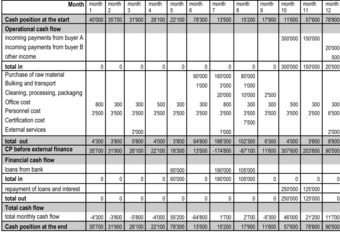
Simple Direct Cash Flow Statement
This is a simple direct monthly cash flow statement from a small business. It’s worth noting that there are no investing activities in this example.
The Indirect Method
The indirect method is quite a bit more involved than the direct method, as it incorporates valuation changes in non-cash assets as well. The structure of the indirect method is also somewhat different, as it starts with the overall net income amount for the reporting period, where operational, investing, and financial changes in valuations are then applied to this amount. The resulting balance is considered the net increase or decrease in overall cash and cash equivalents.
Let’s take a look at some examples of indirect cash flow line items for context:
- Operating items in the indirect method include depreciation and amortization, accounts receivable, inventory, and operating gains and losses.
- Investment items in the indirect method include capital expenditures and investments (i.e. in securities, other businesses, tangible and intangible assets).
- Financial items in the indirect method include dividends, stock repurchases, and changes in overall debt.
When you apply each of these items to the net income of a given period, you will derive a net increase or decrease in overall cash flow as a result of investments, financing, and operations for an organization.
